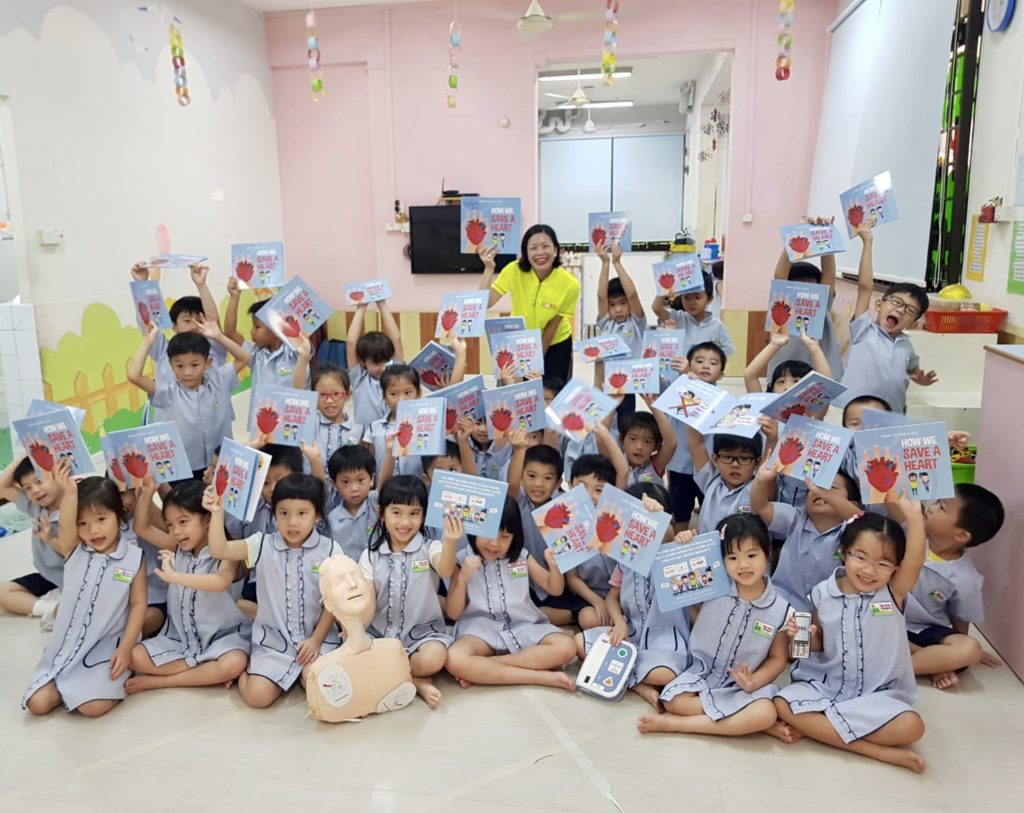DARE X My Little Campus Bishan
Whomever thinks that kids are too young to learn CPR, hasn’t seen kindergarten kids dare to save a heart. On 30th October, my team and I visit My Little Campus on Bishan Street 23. On my way over, I’m delighted to find an AED at the nearby lift lobby.
As my team sets up, I wonder how the session will go. Recently, I had taught a small group of young parents and kids How We Save A Heart Together in a mall and that had gone very well. However that was an intimate session with only accompanied kids. Today I am expecting 40 Kindergarten 1 & 2 kids without their parents. Hence we decide to start by reading from my book, How We Save A Heart, and take it from there.
Kindergarten Kids Dare To Save A Heart
As I read from my book, the children raise their hands excitedly whenever they have questions. Here are 3 of the questions they asked.
“Dr Jade, what is a cardiac arrest?”
I explain that it means someone’s heart has suddenly stopped. Their eyes get very big & round so I show them a diagram in my book. It shows how a heart pumps oxygenated blood around the body. They understand that oxygen is important and that if the heart stops, it cannot pump oxygen to the brain. When I ask them what they must do, they chorus together to use their hands to pump the heart.
“But how can children help?”
Well, kids can always help so don’t run away. For instance they can help the grown-up remember the correct number to call for help. I ask them if they know what it is. Some immediately stick their hands up and wave to get my attention, “995! Call 995 for the ambulance!”
If the grown-up needs to start CPR, he might not know how. So kids can show him the correct hand position.
Finally the grown-up might not know where to look for an AED. The kids tell me AEDs can be found at HDB void decks near the lifts. One solemnly asks, “What happens if we are living on landed property and there is no AED?” I tell him if we can’t find an AED quickly, just continue CPR. After all the ambulance will arrive in about ten minutes in Singapore.
“What if we get electrocuted using the AED?”
Now that’s a really good question. I admit it could be pretty painful so the best thing to do is stay safe and not get electrocuted in the first place. For instance, when we press the shock button, and the AED tells us to stay clear, we should do so. In fact, we practise stretching our arms out to stay clear.
After the reading, I demonstrate the basic steps with the help of some volunteers. They are delighted when they figure out how to use the AED and where to place the pads on the manikin. Their eyes are shining and their confidence is palpable.
What’s The Point Of All This?
Letters to the forum page in the Straits Times fly back and forth discussing the feasibility of schools teaching CPR. If you dissect the Anatomy of A Letter, you’ll see I’m absolutely for schoolchildren learning CPR in schools as part of their core curriculum. They’re not too young at all. In fact, my team published a research paper proving we can improve knowledge & attitudes of schoolchildren towards CPR & AED. This study was conducted among almost 1200 schoolchildren aged 11-17 years old using pre- and post- training surveys. You can read about it in the Singapore Medical Journal http://doi.org/10.11622/smedj.2018021.
What about younger kids? Well, when I teach them CPR, the point is never about achieving perfect compression depth and rate. The emphasis is always teach them how to call for help, as well as to expose them to the idea of helping others. Finally, the message I write in their book signings is: “Be brave.”
We’re so happy the school has agreed to put our book in their library. Hopefully, parents will read these books with their kids and wonder: If kindergarten kids dare to save a heart, why don’t we?

